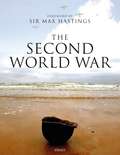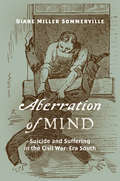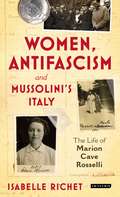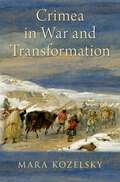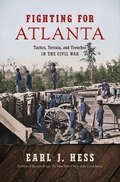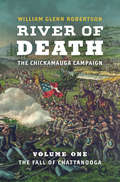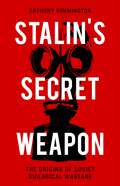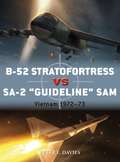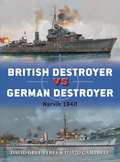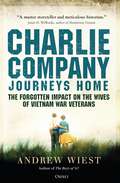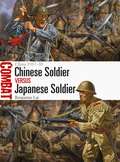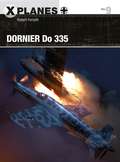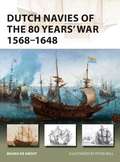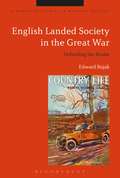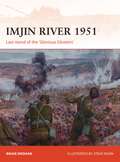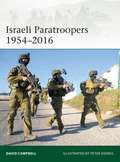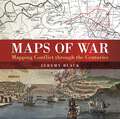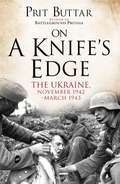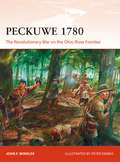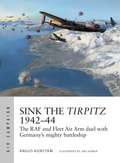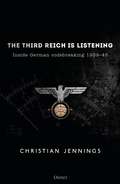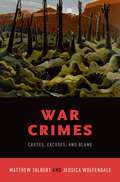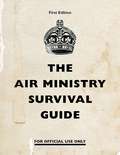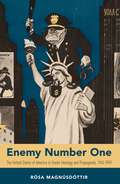- Table View
- List View
The Second World War
by David Horner Robin Havers Alastair Finlan Mark J Grove Philip D Grove Paul Collier Geoffrey Jukes Russell Hart Stephen A. Hart Max HastingsThe period from 1939 to 1945 saw some of the most devastating and remarkable events in living memory. Labouring beneath a daily burden of fear, sacrifice, deprivation and uncertainty, soldiers and civilians of all nationalities were driven to extremes of selfless loyalty, dogged determination or bitter cruelty by the demands of a world at war. This book tells the stories of the men and women who lived and died during the Second World War, from politicians to factory workers, and from High Command to the conscripted men on the front lines. The experience of war is brought to life through a wealth of contemporary documentation, private writings and historical research, whilst the political, military and historical significance of the war is assessed and examined. From Europe's Western and Eastern Fronts to the war at sea, and from the Pacific to the Mediterranean and North Africa, every fighting front of the Second World War is covered in this truly comprehensive volume.
Aberration of Mind: Suicide and Suffering in the Civil War–Era South
by Diane Miller SommervilleMore than 150 years after its end, we still struggle to understand the full extent of the human toll of the Civil War and the psychological crisis it created. In Aberration of Mind, Diane Miller Sommerville offers the first book-length treatment of suicide in the South during the Civil War era, giving us insight into both white and black communities, Confederate soldiers and their families, as well as the enslaved and newly freed. With a thorough examination of the dynamics of both racial and gendered dimensions of psychological distress, Sommerville reveals how the suffering experienced by Southerners living in a war zone generated trauma that, in extreme cases, led some Southerners to contemplate or act on suicidal thoughts.Sommerville recovers previously hidden stories of individuals exhibiting suicidal activity or aberrant psychological behavior she links to the war and its aftermath. This work adds crucial nuance to our understanding of how personal suffering shaped the way southerners viewed themselves in the Civil War era and underscores the full human costs of war.
Women, Antifascism and Mussolini’s Italy: The Life of Marion Cave Rosselli (International Library of Twentieth Century History)
by Isabelle RichetMarion Cave Rosselli is remembered as the 'perfect companion' of the Italian Antifascist leader Carlo Rosselli, assassinated in Paris in June 1937. But little is known about the young English student fired with revolutionary enthusiasm who moved to Florence in 1919, witnessed the violent march of fascism to power and thereafter became a resolute adversary of the Mussolini dictatorship. Based on a wealth of little-used private and public archives, this biography retraces her journey from a modest home on the outskirts of London to the first underground Antifascist opposition in Italy, from the prison island of Lipari to exile in Paris and the United States. It reveals the social, cultural and existential factors which underpinned her unflinching political engagement alongside her husband. It also highlights the many challenges faced by Antifascist women within a highly patriarchal movement by bringing to life the figure of a woman who challenged the traditional division of labour within the family and struggled to carve a political role for herself. Reconstructing Marion Cave Rosselli's experience in relation to the multiple political, social and cultural worlds she moved in, this book broadens our understanding of the Antifascist movement and offers a richly detailed portrait of a time full of hopes, anxieties and disappointments.
Crimea in War and Transformation
by Mara KozelskyCrimea in War and Transformation is the first book to examine the terrible toll of violence on Crimean civilians and landscapes from mobilization through reconstruction. When war landed on Crimea's coast in September 1854, multiple armies instantly doubled the peninsula's population. Engineering brigades mowed down forests to build barracks. Ravenous men fell upon orchards like locusts and slaughtered Crimean livestock. Within a month, war had plunged the peninsula into a subsistence crisis. Soldiers and civilians starved as they waited for food to travel from the mainland by oxcart at a rate of ½ mile per hour. Every army conscripted Tatars as laborers, and fired upon civilian homes. Several cities and villages-Sevastopol, Kerch, Balaklava, Genichesk among them-burned to the ground. At the height of violence, hysterical officers accused Tatars of betrayal and deported large segments of the local population. Peace did not bring relief to Crimea's homeless and hungry. Removal of dead bodies and human waste took months. Epidemics swept away young children and the elderly. Russian officials estimated the devastation wrought by Crimean War exceeded that of Napoleon's invasion. Recovery packages failed human need, and by 1859, the trickle of Tatar out-migration that had begun during the war turned into a flood. Nearly 200,000 Tatars left Crimea by 1864, adding a demographic crisis to the tally of war's destruction. Drawing from a wide body of published and unpublished material, including untapped archives, testimonies, and secret police files from Russia, Ukraine and Crimea, Mara Kozelsky details in readable and vivid prose the toll of war on the Crimean people, and the Russian Empire as a whole, from mobilization through failed efforts at reconstruction.
Fighting for Atlanta: Tactics, Terrain, and Trenches in the Civil War (Civil War America)
by Earl J. HessAs William T. Sherman's Union troops began their campaign for Atlanta in the spring of 1864, they encountered Confederate forces employing field fortifications located to take advantage of rugged terrain. While the Confederates consistently acted on the defensive, digging eighteen lines of earthworks from May to September, the Federals used fieldworks both defensively and offensively. With 160,000 troops engaged on both sides and hundreds of miles of trenches dug, fortifications became a defining factor in the Atlanta campaign battles. These engagements took place on topography ranging from Appalachian foothills to the clay fields of Georgia's piedmont.Leading military historian Earl J. Hess examines how commanders adapted their operations to the physical environment, how the environment in turn affected their movements, and how Civil War armies altered the terrain through the science of field fortification. He also illuminates the impact of fighting and living in ditches for four months on the everyday lives of both Union and Confederate soldiers. The Atlanta campaign represents one of the best examples of a prolonged Union invasion deep into southern territory, and, as Hess reveals, it marked another important transition in the conduct of war from open field battles to fighting from improvised field fortifications.
River of Death--The Chickamauga Campaign: Volume 1: The Fall of Chattanooga (Civil War America)
by William Glenn RobertsonThe Battle of Chickamauga was the third bloodiest of the American Civil War and the only major Confederate victory in the conflict's western theater. It pitted Braxton Bragg's Army of Tennessee against William S. Rosecrans's Army of the Cumberland and resulted in more than 34,500 casualties. In this first volume of an authoritative two-volume history of the Chickamauga Campaign, William Glenn Robertson provides a richly detailed narrative of military operations in southeastern and eastern Tennessee as two armies prepared to meet along the "River of Death." Robertson tracks the two opposing armies from July 1863 through Bragg's strategic decision to abandon Chattanooga on September 9. Drawing on all relevant primary and secondary sources, Robertson devotes special attention to the personalities and thinking of the opposing generals and their staffs. He also sheds new light on the role of railroads on operations in these landlocked battlegrounds, as well as the intelligence gathered and used by both sides.Delving deep into the strategic machinations, maneuvers, and smaller clashes that led to the bloody events of September 19@–20, 1863, Robertson reveals that the road to Chickamauga was as consequential as the unfolding of the battle itself.
Stalin's Secret Weapon: The Origins of Soviet Biological Warfare
by Anthony RimmingtonStalin's Secret Weapon is a gripping account of the early history of the globally significant Soviet biological weapons program, including its key scientists, its secret experimental bases and the role of intelligence specialists, establishing beyond doubt that the infrastructure created by Stalin continues to form the core of Russia's current biological defense network. Anthony Rimmington has enjoyed privileged access to an array of newly available sources and materials, including declassified British Secret Intelligence Service reports. The evidence contained therein has led him to conclude that the program, with its network of dedicated facilities and proving grounds, was far more extensive than previously considered, easily outstripping those of the major Western powers. As Rimmington reveals, many of the USSR's leading infectious disease scientists, including those focused on pneumonic plague, were recruited by the Soviet military and intelligence services. At the dark heart of this bacteriological archipelago lay Stalin, and his involvement is everywhere to be seen, from the promotion of favored researchers to the political repression and execution of the lead biological warfare specialist, Ivan Mikhailovich Velikanov.
B-52 Stratofortress vs SA-2 "Guideline" SAM: Vietnam 1972–73 (Duel)
by Jim Laurier Gareth Hector Peter E. DaviesEver since its introduction in the late 1950s, the B-52 Stratofortress has been the United States' primary heavy bomber and a powerful symbol of its immense military might. Its powerful electronic countermeasures equipment (ECM) was thought to make the B-52 immune to ground-to-air missile attack, but in Vietnam, and later conflicts such as Operation Desert Storm in 1991, it came up against the Soviet-designed SA-2 SAM which used heavy salvoes of missiles to bring down the bombers.The losses of several of its most feared, powerful and supposedly invincible bombers per night to a torrent of Soviet missiles during the closing stages of the Vietnam War was sobering to Americans, but the B-52s' crushing attacks virtually eliminated North Vietnam's defences and forced a peace settlement. This fascinating book analyses the roles of the SA-2 operators and the B-52 Electronic Warfare Officers (EWOs) using specially commissioned artwork as well as first-hand accounts, and traces the cat-and-mouse tactics that each side employed.
British Destroyer vs German Destroyer: Narvik 1940 (Duel)
by Paul Wright David Greentree David Campbell Alan GillilandThe opening months of World War II saw Britain's Royal Navy facing a resurgent German navy, the Kriegsmarine. Following the German invasion of Denmark and Norway in early April 1940, British and German destroyers would clash in a series of battles for control of the Norwegian coast. The operational environment was especially challenging, with destroyer crews having to contend with variable weather, narrow coastal tracts and possibility of fog and ship breakdowns.In two engagements at Narvik, the Royal Navy entered the harbour and attacked the loitering German destroyers who had dropped off mountain troops to support the German invasion. The raids were devastating, halving at a stroke the number at Hitler's disposal. Employing specially commissioned artwork and drawing upon a range of sources, this absorbing study traces the evolving technology and tactics employed by the British and German destroyer forces, and assesses the impact of the Narvik clashes on both sides' subsequent development and deployment of destroyers in a range of roles across the world's oceans.
Charlie Company's Journey Home: The Forgotten Impact on the Wives of Vietnam Veterans
by Andrew WiestThe Boys of '67 and the War They Left BehindThe human experience of the Vietnam War is almost impossible to grasp – the camaraderie, the fear, the smell, the pain. Men were transformed into soldiers, and then into warriors.These warriors had wives who loved them and shared in their transformations. Some marriages were strengthened, while for others there was all too often a dark side, leaving men and their families emotionally and spiritually battered for years to come.Focusing in on just one company's experience of war and its eventual homecoming, Andrew Wiest shines a light on the shared experience of combat and both the darkness and resiliency of war's aftermath.
Chinese Soldier vs Japanese Soldier: China 1937–38 (Combat)
by Johnny Shumate Benjamin LaiIn July 1937, the Marco Polo Bridge Incident sparked a bloody conflict between Chinese and Japanese forces that would rage across China and beyond for more than eight years. The two sides' forces brought very different strengths and limitations to the conflict. In 1937 China was divided into factions, each controlled by warlords with independent forces, and there was no unified Chinese army. In order to fight the Japanese Chiang Kai-shek, the nominal leader of Nationalist China, was compelled to do deals with these regional powers. For their part, the Japanese employed ground forces broadly comparable to those fielded by Western powers, including modern artillery and tanks. Featuring specially commissioned artwork and drawing upon an array of sources, this study investigates the origins, training, doctrine and armament of the Chinese and Japanese forces who fought in the opening stages of the Second Sino-Japanese War.
Dornier Do 335 (X-Planes)
by Robert Forsyth Adam Tooby Wiek Luijken Simon SchatzThe Dornier Do 335 was conceived as a high-speed, all-weather fighter, and represented the pinnacle of piston-engined aircraft design. The Do 335 was a big aircraft, weighing just over 10,000kg when laden with fuel, equipment, and pilot, yet powered by two Daimler-Benz DB 603 engines, it was capable of reaching a maximum speed of 750km/h at 6400 meters, making it the fastest piston engine aircraft produced in Germany during World War II.Some forty aircraft were built between late 1943 and the end of the war, and it was intended to deploy the type as a day fighter, bomber, night fighter, bad weather interceptor, and reconnaissance aircraft, all of which were intended to incorporate the latest armament, bomb sights, communications, and radar equipment, as well as an ejector seat. Featuring archive photography and specially commissioned artwork, this is the full story of the aircraft that the Luftwaffe hoped would turn the tide of the war.
Dutch Navies of the 80 Years' War 1568–1648 (New Vanguard)
by Peter Bull Bouko De GrootThe tiny new state of the United Provinces of the Netherlands won its independence from the mighty Spanish empire by fighting and winning the Eighty Years' War, from 1568 and 1648. In this long conflict, warfare on water played a much bigger role in determining the ultimate victor. On the high seas the fleet carved out a new empire, growing national income to such levels that it could continue the costly war for independence. Yet it was in coastal and inland waters that the most decisive battles were fought. Arguably the most decisive Spanish siege (Leiden, 1574) was broken by a fleet sailing to the rescue across flooded polders, and the battle of Nieuwpoort in 1600, the largest successful invasion fleet before World War II, was one of the most decisive battle in western history. Using detailed full colour artwork, this book shows how the Dutch navies fought worldwide in their war of independence, from Brazil to Indonesia, and from the Low Countries to Angola.
English Landed Society in the Great War: Defending the Realm (Bloomsbury Studies in Military History)
by Edward BujakThe extent to which the Great War impacted upon English landed society is most vividly recalled in the loss of young heirs to ancient estates. English Landed Society in the Great War considers the impact of the war on these estates.Using the archives of Country Life, Edward Bujak examines the landed estate that flourished in England. In doing so, he explores the extent to which the wartime state penetrated into the heartlands of the landed aristocracy and gentry, and the corrosive effects that the progressive and systematic militarization of the countryside had on the authority of the squire. The book demonstrates how the commitment of landowners to the defence of an England of home and beauty - an image also adopted in wartime propaganda - ironically led to its transformation.By using the landed estate to examine the transition from Edwardian England to modern Britain, English Landed Society in the Great War provides a unique lens through which to consider the First World War and its impact on English society.
Imjin River 1951: Last stand of the 'Glorious Glosters' (Campaign)
by Steve Noon Bounford.com Bounford.com Paul Kime Brian DrohanAfter China's November 1950 intervention in the war and the subsequent battle of the Chosin Reservoir, UN forces faced a new onslaught in the spring of 1951 with over 350,000 veteran troops attacking along the Imjin River.The US 3rd Infantry Division took the brunt of the attack along with the attached British 29th Infantry Brigade which included the Gloucestershire Regiment (the “Glosters”). The heroic defence of the American and British forces would pass into legend, most especially the doomed effort of the Glosters, as they sought to buy time for the rest of the UN forces to regroup and organise an effective defence of Seoul, the South Korean capital city. Featuring full colour commissioned artwork, maps and first-hand accounts, this is the compelling story of one of the most epic clashes of the Korean War.
Israeli Paratroopers 1954–2016 (Elite)
by Peter Dennis David CampbellFrom the creation of the first volunteer paratroop unit shortly after the birth of Israel and of the Israeli Defense Force, this arm of service has been recognized as elite. They have also been the first choice for daring special missions, and it is mainly from their ranks that Israel's Special Forces units have been recruited. A unique aspect of the Israeli military is the cross-posting of officers from the airborne, armoured and other units, to ensure that all unit commanders share their aggressive qualities and thorough understanding of the capabilities of all arms. In this way the influence of the paratroop arm has been out of proportion to its size. This fully illustrated study is a complete history of Israeli paratroopers from its creation to the present day, including relevant developments in their role and organization, as well as their achievements and setbacks in conflicts such as the Six Days War and Yom Kippur War.
Maps of War: Mapping Conflict Through the Centuries
by Jeremy BlackThere is little documented mapping of conflict prior to the Renaissance period, but, from the 17th century onwards, military commanders and strategists began to document the wars in which they were involved and later, to use mapping to actually plan the progress of a conflict. Using contemporary maps, this sumptuous new volume covers the history of the mapping of war on land and shows the way in which maps provide a guide to the history of war. Content includes:The beginnings of military mapping up to 1600 including the impact of printing and the introduction of gunpowderThe seventeenth century: The focus is on maps to illustrate war, rather than as a planning tool and the chapter considers the particular significance of maps of fortifications.The eighteenth century: The growing need for maps on a world scale reflects the spread of European power and of transoceanic conflict between Europeans. This chapter focuses in particular on the American War of Independence.The nineteenth century: Key developments included contouring and the creation of military surveying. Subjects include the Napoleonic Wars and the American Civil WarThe twentieth century including extended features on the First and Second World Wars including maps showing trench warfare and aerial reconnaissance. Much of the chapter focuses on the period from 1945 to the present day including special sections on the Vietnam War and the Gulf Wars.
On a Knife's Edge: The Ukraine, November 1942–March 1943
by Prit ButtarLate 1942 saw the strategic situation on the Eastern Front change completely. The encirclement of Paulus' Sixth Army in Stalingrad trapped a significant portion of the Wehrmacht's combat forces in the ruins of the devastated city, where they would ultimately die or be taken prisoner, but at the same time the entire German position was left in a catastrophic state. The year's campaign had seen the Germans advance first east, but then increasingly to the south and southeast; the Soviet counter-offensive not only isolated Sixth Army, it also raised the possibility of the collapse of the entire front. The ultimate failure of the Red Army to achieve this is due in no small part to the efforts of one of the Wehrmacht's greatest commanders: Erich von Manstein, who rebuilt the German front line and fought a mobile campaign, in which all the strengths of the German forces, and all the weaknesses of their Soviet opponents, were revealed. Written by one of the world's leading experts on the Eastern Front, On a Knife's Edge, is a story of brilliant generalship, lost opportunities and survival in the harshest theatre of war.
Peckuwe 1780: The Revolutionary War on the Ohio River Frontier (Campaign)
by Peter Dennis John F. Winkler Nikolai Bogdanovic Bounford.com Bounford.com Paul KimeAs the Revolutionary War raged on fields near the Atlantic, Native Americans and British rangers fought American settlers on the Ohio River frontier in warfare of unsurpassed ferocity. When their attacks threatened to drive the Americans from their settlements in Kentucky, Daniel Boone, Simon Kenton and other frontiersmen guided an army of 970 Kentuckians into what is now Ohio to attack the principal Native American bases from which the raids emanated. This superbly illustrated book traces Colonel George Rogers Clark's lightning expedition to destroy Chalawgatha and Peckuwe, and describes how on 8 August 1780 his Kentuckians clashed with an army of 450 Native Americans, under Black Hoof, Buckongahelas and Girty, at the battle of Peckuwe. It would be the largest Revolutionary War battle on the Ohio River frontier.
Sink the Tirpitz 1942–44: The RAF and Fleet Air Arm duel with Germany's mighty battleship (Air Campaign)
by Jim Laurier Angus KonstamWhen Germany invaded the Soviet Union in the summer of 1941, Stalin requested help from the Western Allies. The result was the Arctic Convoys - the opening of a sea route from Britain to Northern Russia, used to supply the Soviets with vitally-needed war materials. This route passed close to German-occupied Norway, and so in January 1942 the newly-completed battleship Tirpitz - sister of the Bismarck - was sent there, to form the core of the naval force stationed in Northern Norway to intercept these convoys. For more than two years, Tirpitz remained a latent threat to the Allies, and despite fuel shortages her occasional sorties posed a grave threat to Allied shipping. So, the sinking of the battleship became a major priority for the British. The fjords where she lurked were strongly-defended, rendering naval attack virtually impossible. So, unless she could be caught at sea, she had to be destroyed by other means. In the spring of 1942 the Royal Air Force launched three heavy bombing raids on the battleship's anchorage, but no hits were scored. The following autumn she was damaged during a midget submarine attack, and moved to a more secure anchorage. A lack of bombers caused a hiatus in these air attacks, but they were resumed in 1944, by which time the Fleet Air Arm had the resources to join in the air campaign. The most sustained of these naval air operations was Operation Goodwood, but like the others, its results were disappointing. It was now clear that only heavy bombers dropping especially heavy bombs could do the job. So, that autumn the RAF launched the first of three large-scale attacks using Lancaster bombers armed with enormous Tallboy bombs. In the first, codenamed Operation Parvane, the Tirpitz was badly damaged. In the third air attack, carried out in November 1944, the battleship was hit three times, and she capsized and sank, taking most of her crew down with her. Her passing broke German naval power in Arctic waters, which in turn allowed the Allies to divert their naval resources to the Pacific, where the ocean-wide campaign was reaching its climax. The air campaign against the Tirpitz was one of vital strategic importance, and while low-key compared to air operations over mainland Europe, it was one where a single bomb could dramatically influence the course of the war. These British airmen faced tough opposition from the weather, terrain, ground defences, the Luftwaffe and from the well-armed battleship herself, which, while rendering it tough for them, make this a dramatic story of air power's triumph against the odds. Technically, the 1944 air campaign was a test bed for a new generation of super-bomb. The Tallboy, designed by Barnes-Wallis of Dambuster fame, was a five ton "seismic bomb", capable of destroying the battleship when other more conventional ordnance had failed. These ground-breaking bombs were the forerunners of the devastating bunker-busting weaponry of the post-war era.
The Third Reich is Listening: Inside German codebreaking 1939–45
by Christian JenningsThe codebreakers at Bletchley Park have been immortalised in films such as The Imitation Game and Enigma, but the Germans were also breaking Allied ciphers. The Third Reich is Listening is the comprehensive account of the successes, failures and science of Germany's codebreaking and signals intelligence operations from 1935 to 1945. This fast-moving blend of modern history and popular science is told through colourful personal accounts of the Germans at the heart of the story, including a former astronomer who worked out the British order of battle in 1940, a U-Boat commander on the front line of the Battle of the Atlantic and the woman from the foreign ministry decrypting Japanese and Italian signals.It investigates how and why a regime as technologically advanced as the Third Reich both succeeded, and failed, in its battle to break their enemy's codes and to use the resultant intelligence effectively, and why they failed to recognise the fact that the Allied had cracked the enigma code.
War Crimes: Causes, Excuses, and Blame
by Matthew Talbert Jessica WolfendaleIn 2005, US Marines killed 24 unarmed Iraqi civilians in the town of Haditha, including several children. How should we assess the perpetrators of this and other war crimes? Is it unfair to blame the Marines because they were subject to situational pressures such as combat stress (and had lost one of their own in combat)? Or should they be held responsible for their actions, since they intentionally chose to kill civilians? In this book, Matthew Talbert and Jessica Wolfendale take up these moral questions and propose an original theory of the causes of war crimes and the responsibility of war crimes perpetrators. In the first half of the book, they challenge accounts that explain war crimes by reference to the situational pressures endured by military personnel, including peer pressure, combat stress, and propaganda. The authors propose an alternative theory that explains how military personnel make sense of their participation in war crimes through their self-conceptions, goals, and values. In the second half of the book, the authors consider and reject theories of responsibility that excuse perpetrators on the grounds that situational pressures often encourage them to believe that their behavior is permissible. Such theories of responsibility are unacceptably exculpatory, implying it is unreasonable for victims of war crimes to blame their attackers. By contrast, Talbert and Wolfendale argue that perpetrators of war crimes may be blameworthy if their actions express objectionable attitudes towards their victims, even if they sincerely believe that what they are doing is right.
The Air Ministry Survival Guide (Air Ministry Survival Guide)
by NoneTHE ULTIMATE SURVIVAL GUIDE for anyone who thinks they'd survive the world's most hostile environments - or at least imagine they could do.THE ULTIMATE SURVIVAL GUIDE for anyone who thinks they'd survive the world's most hostile environments - or at least imagine they could do.-----------------------------First issued to British airmen in the 1950s the beautifully illustrated Air Ministry Survival Guide provides invaluable practical tips and instruction on how to keep calm and carry on in any hostile environment.Whether you're lost in the desert, arctic, jungle, or adrift on the open ocean, you'll be better off armed with sensible advice on how to:- Build a structurally sound igloo- Pull faces to prevent frostbite (and when to expect bits to fall off should you fail)- Fashion a mask to prevent snowblindness- Make a hat out of seat cushions- Behave in the event of meeting hostile locals- Stay safe from poisonous reptiles and insects- Use a 'fire thong'- Punch man-eating sharks (which are cowards)
Enemy Number One: The United States of America in Soviet Ideology and Propaganda, 1945-1959
by Rósa MagnúsdóttirEnemy Number One tells the story of the Soviet cultural and propaganda apparatus and its efforts to control information about the United States in the postwar landscape. Beginning with the 1945 meeting of American and Soviet troops on the Elbe, this period saw cultural relations develop in close connection to oppression as the Soviet authorities attempted to contain and appropriate images of the United States. Rósa Magnúsdóttir analyzes two official narratives about the USSR's "enemy number one" --Stalin's anti-American campaign and Khrushchev's policy of peaceful coexistence--and shows how each relied on the legacy of the wartime alliance in their approach. Stalin used the wartime experience to spread fear of a renewed war, while Khrushchev used the wartime alliance as proof that the two superpowers could work together. Drawing from extensive archival resources, Magnúsdóttir brings to life the propaganda warriors and ideological chiefs of the early Cold War period in the Soviet Union, revealing their confusion and insecurities as they attempted to navigate the uncertain world of late Stalin and early Khrushchev cultural bureaucracy. She also demonstrates how concerned Soviet authorities were by their people's presumed interest in the United States, resorting to monitoring and even repression-behavior indicative of the inferiority complex of the Soviet project as it related to the outside world.
Postcards from the Trenches: A German Soldier’s Testimony of the Great War
by Irene GuentherGerman art student Otto Schubert was 22 years old when he was drafted into the Great War. As the conflict unfolded, he painted a series of postcards that he sent to his sweetheart, Irma. During the battles of Ypres and Verdun, Schubert filled dozens of military-issued 4” x 6” cards with vivid images depicting the daily realities and tragedies of war. Beautifully illustrated with full-color reproductions of his exquisite postcards, as well as his wartime sketches, woodcuts, and two lithograph portfolios, Postcards from the Trenches is Schubert's war diary, love journal, and life story. His powerful artworks illuminate and document in a visual language the truths of war. Postcards from the Trenches offers the first full account of Otto Schubert, soldier-artist of the Great War, rising art star in the 1920s, prolific graphic artist and book illustrator, one of the “degenerate” artists defamed by the Nazis, and a man shattered by the Second World War and the Cold War. Created in the midst of enormous devastation, Schubert's haunting visual missives are as powerful and relevant today as they were a century ago. His postcards are both a young man's token of love and longing and a soldier's testimony of the Great War.
